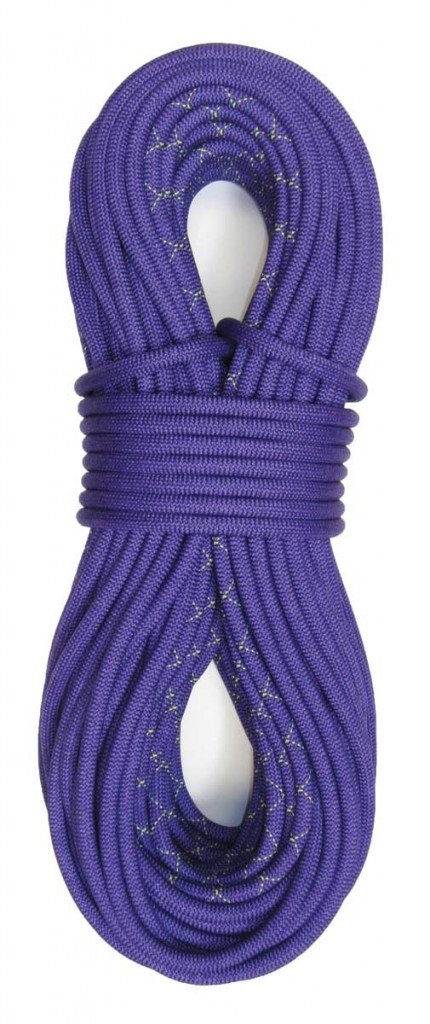Sterling Nano 80m Rope Review
 I remember the first time I heard about 80m ropes. We were finishing up on the Indian Creek mega-classic Spaghetti Western, and some Spaniards were hopping on the line next. We had done it with a 70m cord, and we asked how long their rope was, just to make sure they’d be OK on the lengthy pitch. “Eighty meters,” they replied, and we felt a little sheepish, of course they’ll be alright, they’re Spaniards!
I remember the first time I heard about 80m ropes. We were finishing up on the Indian Creek mega-classic Spaghetti Western, and some Spaniards were hopping on the line next. We had done it with a 70m cord, and we asked how long their rope was, just to make sure they’d be OK on the lengthy pitch. “Eighty meters,” they replied, and we felt a little sheepish, of course they’ll be alright, they’re Spaniards!
It’s been several years since that day in the desert, and 80m ropes are still a rarity in the US. My sources overseas tell me it’s become more common place in Europe, but here in the land of the free, 60m seems to be holding strong as the standard. I’d been wanting an 80m for awhile, as we spend a lot of time in Indian Creek, where the pitches can be very long, and sometimes require two ropes to get off. I knew I’d have to get a small diameter, to justify the extra length, but after climbing the last two years on a 9.4, I was ready to make the jump. This fall we got a 9.2 Bicolor 80m Sterling Nano, and it was off to the races to see what this thing could do.
On our first trip to the Creek, I was a little hesitant, but that uncertainty was soon put to rest: it was a dream to climb on. The skinny cord clipped with ease, and at the top of a long pitch, you didn’t notice the weight, or the drag, nearly as much as on something like a 9.8. It’s fairly stretchy, but feels about the same as our 9.4, which we use for everything. And with 262 feet of rope, we could now get off pitches that were over 130 feet long, without having to tag along another cord. Which leads us to the other reason we fell in love with this rope.
There’s a climb at Red Rocks we had been on once before, but ran out of time due to a variety of factors, so we were headed back as a team of two to get it done. Normally you’d need two ropes for the nine rappels, but looking at the pitch lengths, we knew we could do it with a single 80m. It was a great day of climbing, where the pitches flew by, the climbing supremely enjoyable, and life at the belays made all the more simple by not having to deal with the cluster of a second rope. Now, I truly hate climbing with two ropes, as the added complexity of the situation is offensive to my sense of aesthetics, so for me, to be able to leave the ground with only one was incredibly liberating. It also gave us one less thing to worry about on the way down, as there was no knot to get snagged on flakes each time we pulled the rope.
I’ve only got one complaint so far, and that’s how kinked the cord was/is. It’s taken a long time to work out 262 feet of twists, which gets to be a pain after a while. I’m also a little concerned about the durability, as it’s such a skinny line, but so far I have no complaints. If you spend much time in the desert or anywhere with long pitches, or just want a light and long rope for multipitch routes, be sure to give this thing a look.
You can get full tech specs and more info on the Sterling website.
Disclaimer: This product was provided to SplitterChoss.com for the purpose of reviewing. Don’t worry, though, our integrity can’t be bought!
2 Responses to Sterling Nano 80m Rope Review
Bulldog Creek Dog Walk (IV WI 4+)
Hayden Carpenter and Tom Bohanon recently repeated an obscure ice climb on the south side of Mt Sopris. Given a brief mention in Jack Robert’s ice guide, Bulldog Creek Walk is described as being 100 meters of WI 4. What they found was seven pitches of ice in a remote setting that makes for one […]
Connect with Us















I’ve got an 80m and I really like it. It’s not for everything but with an 80 and a 60m I rarely have to take a 2nd cord for raps.
Which climb in red rocks??? 🙂
How’s the rope holding up to abuse?